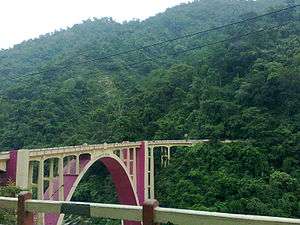Coronation Bridge

The Coronation Bridge, also known as the Sevoke Bridge, in Darjeeling district of West Bengal, India, spans across the Teesta River, connecting the districts of Darjeeling and Jalpaiguri. National Highway 31 runs across it.
It was named to commemorate the coronation of King George VI and Queen Elizabeth in 1937 and was completed in 1941 at a cost of Rs 4 lakhs.[1] The foundation stone of the bridge was laid by John Anderson, the-then Governor of Bengal in 1937.
Locals call the bridge Baghpool, meaning tiger bridge, because of the two lion statues (bagh actually means tiger) at one entrance of the bridge. The bridge is also called Lohapul (Iron Bridge) as it is made of steel.
John Chambers, the last British executive Engineer of the Darjeeling Division Public Works Department (PWD), carried out the design, drawing and planning of the bridge. Messrs J.C. Gammon, from Bombay, was the contractor. The bridge was built on the Reinforced Concrete system. Since it was not possible to obtain support from the Teesta river bed due to the depth and current of water, the entire bridge was supported by a fixed arch, which had its two ends fixed on rock layers on either side of the river. “Given its architectural and historical value, the bridge should be declared a heritage site. Traffic should be regulated and maintenance work carried out properly,” Bagchi said.
In April 2013 49-year-old Sailendra Nath Roy died trying to cross the Teesta canyon directly near the bridge only being attached to a steel cable by his head of hair.

References
| Wikimedia Commons has media related to Coronation Bridge. |
Coordinates: 26°54′10″N 88°28′24″E / 26.902855°N 88.473265°E